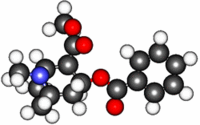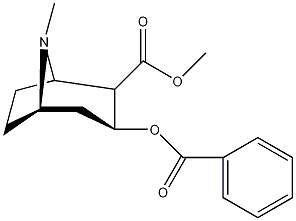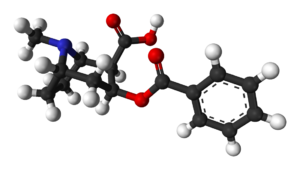It07:Cocaine
Cocaine
| Cocaine | |
|---|---|

| |
| General | |
| Systematic name | methyl (1R,2R,3S,5S)-3- (benzoyloxy)-8-methyl-8-azabicyclo[3.2.1] octane-2-carboxylate |
| Molecular formula | C17H21NO4 |
| Molar mass | 303.353 g/mol |
| Appearance | White powder |
| CCDC Class | Alkaloids |
| CAS number | 50-36-2 |
| Physical Data | |
| Solubility in water | 1800 mg/mL (20 °C) |
| Melting point | 195 °C (383 °F) |
| Pharmacokinetic data | |
| Bioavailability | Oral: 33% Nasal: 19% |
| Hazards | |
| MSDS | [External |
| Except where noted otherwise, data are given for materials in their standard state (at 25 °C, 100 kPa) Infobox disclaimer and references | |
Vioxx |



History of Cocaine
Now cocaine is an integral part of the world economy. The active ingredient (an alkaloid) from the coca plant (erythroxylum) was isolated firstly by a chemist. This chemist is named Albert Niemann. In 1860, he named the compound cocaine. The drug produces a sense of exhilaration. It is primarily by blocking the reuptake of the neurotransmitter dopamine in the midbrain. After it was first synthesized, cocaine was almost available everywhere. Sometimes it is available in powder form and was also mixed with various other products,such as cigarettes and wine. Doctors dispensed cocaine, beacuse it is an antidote to morphine addiction. Some patients unfortunately made a habit to combine them.
Forms of Cocaine
Cocaine Hydrochloride
This is the typical form of cocaine; a white powder salt of cocaine. It is synthesised from the leaves of one of two species of erythroxylon plants -- erythroxylon coca and erythroxylon novogranatense.Coca leaves are firstly pulverized; mixed with an alkaline material, an organic solvent and water, and then shaken. The water and leaves are subsequently discarded. Sulphuric acid is then mixed with the solution to remove residual components. Baking soda is added and the mixture is dried, creating a white, putty-like substance called "coca paste". Coca paste is almost always converted into powder cocaine. This is accomplished by, first, dissolving coca paste in aqueous hydrochloric acid, potassium salt is then added to separate undesired substances from the mixture. The final step is to add ammonia; powder cocaine precipitates out and is subsequently dried.
Cocaine Freebase
As the name suggests; this form of cocaine is the base form of cocaine. Freebase is cocaine hydrochloride that has been reverse-engineered back to it's base state, rendering it smokeable. Freebase cocaine is manufactured by dissolving powdered cocaine in a highly basic solution, such as aqueous ammonia, to remove the hydrochloric acid. Upon addition of ether, or other organic solvents, freebase crystallises out.
Crack Cocaine
Crack cocaine is, in principle, cocaine freebase that has not been crystallised out of organic solvents. Powdered cocaine hydrochloride is dissolved in a solution of baking soda and water. When this solution is boiled a solid substance precipitates out. This solid substance is removed and allowed to dry, the resulting dried chunks are crack cocaine.
Coca Leaves
For centuries, the large Indian population of Peru have chewed coca leaves. They were enjoyed in a similar way to the modern consumption of coffee and caffeinated products, i.e. they afforded a short burst of energy and stamina.A coca leaf typically contains between 0.1 and 0.9 percent cocaine. If chewed in such form, it rarely results in social or medical problems for the user.
Detection
The detection of cocaine, and by extension all illegal drugs, has become more important in the past decades. Cocaine is easily detected in the urine of users. The hydrolysis of cocaine in the liver results in the formation of a detectable metabolite, benzoylecgonine. Benzoylecgonine is subsequently excreted with urea after being processed by the liver.

Methods of Ingestion
Insufflation
This form of ingestion, also known as 'snorting', is the most common method of ingestion in the Western World. Instead of being inhaled, the cocaine merely coats the inside of the sinuses and is subsequently absorbed through the mucus membranes. Excess cocaine not absorbed is collected in mucus and swallowed. This is referred to as 'the drip' and can be considered pleasant or unpleasant depending on personal preference. Damage to the inside of the nose can result from constant insufflation of cocaine; due to the cocaine constricting blood vessels and stopping blood flow to the area. Cocaine is firstly divided into 'lines' before insufflation; with 'tooters' being used to aid ingestion. Tooters can take the form of rolled up banknotes, hollowed-out pens, pointed ends of keys, specialized spoons and cut straws.
Injection
Drug injection allows for the quickest and highest levels of cocaine into the system. After injection, cocaine reaches the brain in seconds and can cause, to the uninitiated, such an intense rush that the user vomits uncontrollably.
Smoking
This form of ingestion can only be achieved with cocaine freebase or crack cocaine. A 'crack pipe' is usually employed for smoking both forms; ranging from discarded fizzy drink cans to deep sockets.
Coca Leaf Infusions
The free and legal commercialization of dried coca leaves as "coca tea" has been actively promoted by the governments of Peru and Bolivia for many years as a drink with medicinal powers.
Chewing/Eating
Coca Leaves are normally mixed with a highly alkaline substance, such as lime, and chewed in the mouth. The drug being absorbed through the inner membrane of the cheek. The leaves are chewed with lime so as to temporarily neutralise the acidity of the stomach; cocaine is hydrolysed and rendered inactive in the acidic stomach. Chewing with lime allows for further assimilation through the stomach.
